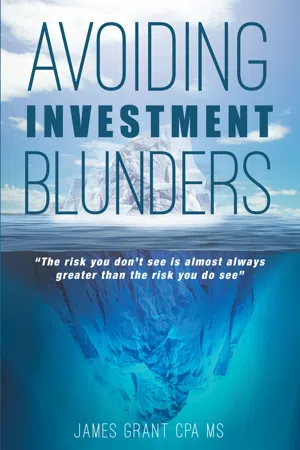
- English
- ePUB (mobile friendly)
- Available on iOS & Android
Avoiding Investment Blunders
About this book
There are two parts to the investment equation: (1) How to make money from investing and (2) how to avoid losing it. This book deals with the second objective.
Investors can prosper from small mistakes because they teach valuable lessons, but large mistakes (blunders) wipe out large amounts of capital and ruin lives. Blunders result in lost opportunities, children not going to college, or retirement being postponed or permanently abandoned. Severe losses can produce depression, failed marriages, and even suicide.
How do investors stumble into blunders? They are not prepared, and they are ill-informed. They invest in inappropriate investments, and their timing is bad. They listen to bad forecasts by economists, portfolio managers, CEOs, journalists, and security analysts. Just because an investment product exists does not mean it should be bought. Some investments like mortgage bonds and variable annuities are structurally flawed and too dangerous for average investors.
Blunders occur as a result of misleading statements by the media. They also occur due to scams. Investors are way too gullible and greedy. The investment landscape is treacherous, and it is important for investors to pay attention and employ healthy amounts of skepticism. Investors must employ less emotion and more reason. Investing is not a hobby!
There are many resources to guide investors on how to make money in investing, but there are few guides on how to avoid losing money. The information deficit in Avoiding Investment Blunders is significant. This book contains detailed guidance and occasional colorful examples of the author s missteps and the mistakes of others.
Investment blunders are, therefore, financial disasters that must be avoided at all cost. Investment blunders usually only happen once per person per lifetime. This book will help ensure that blunders do not happen at all!
Frequently asked questions
- Essential is ideal for learners and professionals who enjoy exploring a wide range of subjects. Access the Essential Library with 800,000+ trusted titles and best-sellers across business, personal growth, and the humanities. Includes unlimited reading time and Standard Read Aloud voice.
- Complete: Perfect for advanced learners and researchers needing full, unrestricted access. Unlock 1.4M+ books across hundreds of subjects, including academic and specialized titles. The Complete Plan also includes advanced features like Premium Read Aloud and Research Assistant.
Please note we cannot support devices running on iOS 13 and Android 7 or earlier. Learn more about using the app.
Information
- Emotional vs. Rational Blunders
Table of contents
- Avoiding Investment Blunders
- Foreword
- Part I: The Enemy Within
- Chapter 1: The Nature of Blunders
- Chapter 2: Investor, Know Thyself!
- Chapter 3: Investment Bias
- Part II: Players Who Will Help You Make Blunders
- Chapter 4: Security Analysts—Asleep at the Switch
- Chapter 5: Investment Strategists and Economists—Perpetually Bullish
- Chapter 6: Corporate CEOs and Directors—Hopelessly Conflicted
- Chapter 7: Mutual Funds—Divided Loyalties
- Chapter 8: Investment Newsletters—Abusing the First Amendment to the Constitution
- Chapter 9: Journalists—Not Even the First Amendment Will Help
- Chapter 10: Investment Scam Artists—An Easier Way to Lose it Quicker
- Part III: How to Lose Money in Bonds
- Introduction
- Chapter 11: Bonds—A Deceptively Dangerous Investment
- Chapter 12: Maturity Risk—Unique to Bond Mutual Funds
- Chapter 13: You Can’t Lock In a Rate of Return with Bond Funds
- Chapter 14: Mortgage-Backed Securities—Structurally Flawed
- Chapter 15: Bonds and the Economic Cycle
- Chapter 16: High Yield Bonds and the Economy
- Chapter 17: Zero-Coupon Bonds—Volatile, Expensive
- Chapter 18: Balanced and Target-Date Funds
- Part IV: How to Lose Money in Stocks
- Chapter 19: Forget to Say “Sell”
- Chapter 20: Ignore Fiscal, Tax, and Regulatory Policy
- Chapter 21: Ignore the Fed
- Chapter 22: Ignore Wars!
- Chapter 23: Buy and Hold
- Chapter 24: Myths and Fables of Annuities
- Glossary
- About the Author